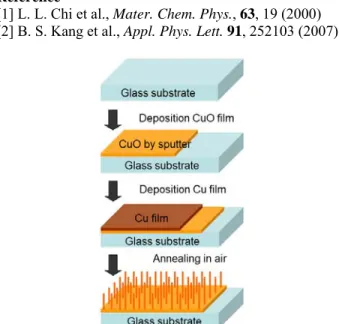Sensing Performance of EGFET pH Sensors with CuO Nanowires Fabricated on glass substrate
Tsung-Han Yang1, Sheng-Po Chang1,*, Chih-Wei Li1, and Shoou-Jinn Chang1
1Institute of Microelectronics & Department of Electrical Engineering, Center for Micro/Nano Science and Technology, Advanced Optoelectronic Technology Center National Cheng Kung University, Tainan, Taiwan
*E-mail: changsp@mail.ncku.edu.tw
Abstract- In this work, the sensing membrane of extended-gate field-effect-transistor (EGFET) pH sensors with an intrinsic copper oxide (CuO) nanowire array was fabricated on a glass substrate by directly heating a Cu film at 450°C for 5 h in air. It was found that the average length and average diameter of these nanowires (NWs) were 2.5μm and 70nm, respectively. The resulting EGFET pH sensors with CuO NWs exhibited significantly improved sensing performances owing to the large sensing surface-to-volume ratio. The pH sensitivity calculated from the linear relation between the drain- source current and the pH value was 23.5μA/pH and that calculated from the linear relation between the reference voltage and the pH value was 18.4 mV/pH.
Experiments- For the fabrication of the EGFET sensors, before growing the CuO NWs, glass substrates were wet- cleaned by acetone and deionized water and then baked at 100°C for 10 min to remove moisture. A 100-nm-thick CuO layer was first deposited onto the glass substrates by DC sputtering to serve as the adhesion and conducing layer. We maintained the flow rates of Ar and O2 at 15 and 6 sccm, respectively. A pure copper thin film with a thickness of 0.5μm was subsequently deposited on top of the CuO layer. The samples were then placed in a furnace and annealed at 450°C in air for 5h to grow CuO NWs.
The procedure used to grow the CuO NWs is schematically shown in Fig. 1. An X-ray diffractometer (XRD) was then used to characterize the crystallography for various thicknesses (0.1, 0.3, 0.5, 1, 2, and 3μm) of the Cu thin film and 100-nm-thick CuO layer. The surface morphology of the samples and the size distribution of the NWs were characterized using a field-emission scanning electron microscope (FESEM). To measure the sensing performances of the fabricated pH sensors, the pH sensor and the Ag/AgCl reference electrode were dipped into the detection solution (pH value varied from 4 to 10). The CuO conducting layer of the EGFET was connected to the gate of a commercial MOSFET device. The sensing response of the pH sensors was measured using an Agilent 4156C analyzer.
Results and Discussion- The measured dependence of the drain-source current (IDS) on the drain-source voltage (VDS) of the EGFET with CuO NWs (length=2.5μm) operated at a reference electrode voltage (VREF) of 3V is shown in Fig. 2. The experimental results showed that IDS
decreased with an increase in the pH value of the detection solution. This dependence was attributed to the accumulation of H+ ions on the sensing surface in the acidic solution, which was equivalent to applying an extra positive voltage at the gate of the MOSFET. On the other hand, the IDS decreased with the pH value in the basic solution due to the accumulation of OH− ions, which was equivalent to application of an extra negative voltage at the gate of the MOSFET. Therefore, we concluded that the drain-source current can be modulated by varying the pH value of the detection solution. The obtained reference
voltage is shown as a function of the pH value in Fig. 3.
The sensitivity was defined as the dependence of the obtained reference voltage on the pH value. The sensitivity was calculated from the linear relation between the reference voltage and the pH value. From the experimental results shown in Fig. 3, the sensitivity of the pH sensors with CuO NWs was found to be 18.4 mV/pH.
Acknowledgement- The authors would like to thank the National Science Council and Bureau of Energy, Ministry of Economic Affairs of Taiwan, R.O.C. for the financial support under Contract No. 100-2221-E-006-168 and 101-D0204-6 and the LED Lighting Research Center of NCKU for the assistance of device characterization.
Reference
[1] L. L. Chi et al., Mater. Chem. Phys., 63, 19 (2000) [2] B. S. Kang et al., Appl. Phys. Lett. 91, 252103 (2007)
Figure 1. Procedure used to grow CuO NWs and procedure used to fabricate CuO-NW pH sensors.
Figure 2. Drain-source current vs. drain-source voltage characteristics of pH sensor with CuO NWs.
Figure 3. Reference voltage as a function of pH value.
